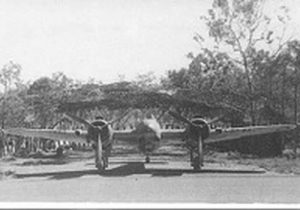War History Page 2

During December, top cover was provided on the 6th for the corvette “Kalgoorlie” and for the Dutch destroyer “Tjerk Hiddes” between the 10th and 20th when eight missions were flown. Towards the end of the month, No. 31 Squadron protected the convoy, which included the “Wilcannia”, “Babinda” and “Darvil”.
In a most successful attack on the 2nd December, No. 31 Squadron gave Penfoei aerodrome a thorough strafing, pounding machine-gun posts, searchlight positions, personnel and fuel dumps and damaging or destroying by fire approximately three fighters and fifteen twin-engined bombers out of twenty-five on the ground. On the same day, other squadron aircraft searched the Timor Sea for a possible enemy warship. December the 15th witnessed the day on which the squadron completed its 100th operation.
An unusual assignment was completed on the 18th December by two aircraft, which attacked an enemy sailing vessel, believed to be carrying spies to Saumlaki. When the aircraft left the scene, the boat was burning and in a sinking condition. The Timor ventures did not divert attention from the islands to the, north of Darwin and enemy activities were observed and impeded to a material extent.
The aerial offensive from North Western Area against Fuiloro and Laivai – Laga districts – the latest advancement of Japanese activities at this time – was stepped up from the 20th December. No. 31 Squadron participated in this major burst with five attacks against the aerodrome and other installations at Fuiloro on the 22nd 23rd 24th 27th and 28th and three on the 25th 26th and 27th against the bivouac and storage areas in the Laivai-Laga districts.
On the latter two occasions the squadron put ten aircraft into the air. In the attack on the 23rd one Jap fighter was shot down and one damaged, while one of the Beaufighters whose crew were Sergeant Hand and Warrant Officer Smith, was posted missing, having turned back from the target due to engine trouble.
All possible weight was mounted into these attacks, culminating on the 29th in a strafing attack against Betano. The four Beaufighters briefed for the mission to Betano experienced several misfortunes; one returned to base unserviceable, a second with Sergeant Webb and Flight Sergeant Wilkins as crew was posted missing, and a third crashed into the sea near Cape Helvetius and the crew were later rescued.
In most of these operations, the Beaufighters of No. 31 Squadron were the spearhead of sustained blows against enemy preparations in the new area. By the end of 1942, the squadron was equipped with twenty-four Beaufighters. The pressure against Portuguese Timor, commenced in December, was maintained into 1943. Fuiloro, Laivai and Baucau, on the 4th January, received further strafing attacks from the Beaufighter aircraft, resulting in one grounded zero being destroyed at Fuiloro.
A fault was evident in the work of this aircraft. Timor was mountainous and heavily timbered. The aircraft was fast and in most operations skimmed the tree tops. For these reasons when motor transport was discovered on the roads, it was impossible to turn quickly for a strafing attack, leaving the enemy ample time to disperse under cover.
Operations by the Beaufighters in their hunting grounds, Fuiloro, Laivai Laga and Baucau areas were outstanding and paid dividends for light casualties. Between its strafing sweeps, the squadron flew many missions over the seas on convoy cover and searches for enemy shipping. This hard worked squadron, also opened a devastating campaign against floatplane bases, in the Aroe Islands. In its first attack on the 28thJanuary it destroyed a grounded plane at Dobo.
No. 31 Squadron added to its already spectacular record, a strafing raid on Penfoei Aerodrome on the last day of the month. A probable ammunition dump exploded hurling fragments to 1200 feet, damaging one of the six aircraft engaged. Two buildings were fired, three grounded aircraft destroyed by fire and four bombers and one fighter probably destroyed on the ground. Motor transport was also strafed. One airborne fighter vainly attempted to intercept, but the attacking aircraft escaped on account of superior speed.
The Beaufighters co-operated with Hudsons and Mitchells during the next few weeks in a concentrated move against Dobo.
Considerable damage was inflicted on stores, buildings, installations and the jetty. Single strikes by Beaufighters in succeeding weeks made the use of Dobo by floatplanes a losing proposition. Still Fuiloro and the surrounding district was always kept on No. 31 Squadron’s schedule.
At Dobo, on the 4th February, another floatplane was damaged on the water, and one Beaufighter outmanoeuvred an attack by another floatplane, escaping safely.
When the squadron revisited Dobo on the 10th, the site seemed deserted. On the 13th four of the squadron’s aircraft returned to shoot up Fuiloro. Buildings and huts near the strips were strafed. The strip, however, seemed deserted. Among the tasks allotted to the squadron at this time was shipping protection reconnaissances, anti-submarine patrols and fighter cover, all of which were shared with Nos. 2, 13 and 18 squadrons. Out of 57 sorties for the month of February, 45 were devoted to monotonous hours in this necessary duty over ships at sea. Only on one occasion was the mission spiced with action against enemy aircraft.
On the 20th bombs were dropped close to the Beaufighter’s brood and in the ensuing action one of our aircraft was damaged.
February closed with the highlight of the month, an attack on Penfoei by eight Beaufighters. This onslaught probably caused a serious hold-up in enemy plans, as the R.A.A.F. harassers destroyed nine fighters and four bombers on the ground and inflicted damage on nine other aircraft, in addition to silencing one ack-ack and one machine gun position. Interception was made by two or three Zekes, one of which was possibly damaged. Unfortunately, two of the attacking Beaufighters sustained damage.
